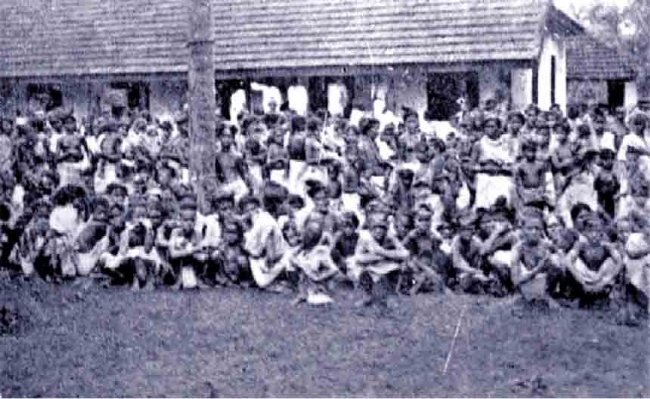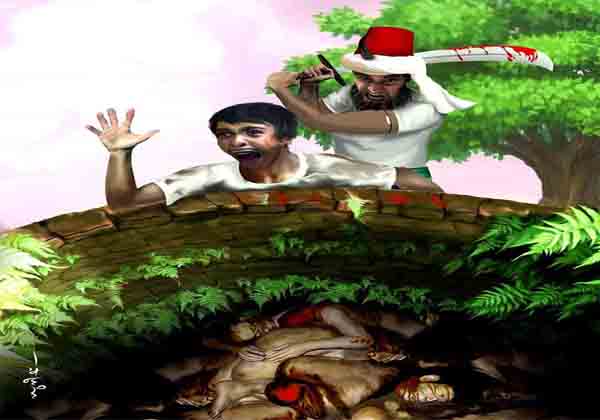The Hindu Genocide of Malabar in the erstwhile Madras Province in 1921 was not an isolated event but a culmination of a slew of communal outbreaks which were happening intermittently throughout the 19th century. According to records, Malabar had witnessed nearly 51 such communally-inspired incidents of violence by Mappilas, mostly against hapless and unarmed Hindus. However, the events in 1921 differ in its scale, scope and degree even though the ideology, inspiration and the tools of motivation of the Mappila masses remained consistent.
The Malabar rebellion was a well-planned jihad against the British and the Hindu population. Fanatic Mappilas had indulged in mass killings, loot, rapes since August 1921. It spilled over to four taluks of Malabar spanning an area of 2,000 square miles.
Malabar comprised of the present-day districts of Palakkad, Malappuram, Kozhikode, Kannur, Wayanad, and parts of Kasargod. Of the total population of nearly 1 million, Mappilas formed nearly 32 per cent. In Ernad Taluk, which was the epicentre of the rebellion (which is roughly the present day Malappuram district), Muslims were in a majority.
In terms of participation of the Mappilas, we can say with some amount of certainty that a large percentage of the Mappila population of that area were either an actively or passively participated in the mayhem. According to the official sources, nearly 2,500 of Mappila rioters were killed, 1,652 were wounded, 5,955 were captured, nearly 40,000 were surrendered of which many of them were tried and convicted. This figure indicates that there was a widespread participation of ordinary Mappilas, including women and children.
As far as Hindu victims are concerned, we do not have any official figures. Yet from the writings, statements of victims and available documents, we can conclude the riots claimed thousands of lives about 10,000. Estimates shows that nearly 300 temples were partially or fully damaged, properties worth crores of rupees belonging to Hindus were looted or burned. Nearly 2 lakh Hindu refugees reached in various relief camps in neighbouring districts. One can vouch that no Hindu family were remained unaffected in Eranad.
Jihadi goons ambushed the convoys of refugees and many were killed, robbed and raped. Those Hindus, who were fortunate to reach relief camps in Kozhikode or Shornur, lost everything except what they wore.
The unspeakable violence committed by the Mappila mobs against unarmed and hapless Hindus was not an ordinary crime. By its entire attribute, it should be called as genocide. According the definition of the term genocide by Rome Statute of the International Criminal Court, killing members of a group or causing serious mental or bodily harm with intent to destroy, in whole or part, a national or religious group can be termed as genocide.
The intent of the Mappilas was very clear. They were determined to over throw the British Raj and to establish an Islamic kingdom, a Mappila Raj, with their own Islamic king, flag, seal and other paraphernalia, to be administered on the basis of Islamic legal system called Sharia. However, very soon they found that this idea of Islamic State won’t be acceptable to the Hindus who constituted not less than 30 per cent of the population. Even the Hindu Congress leaders, who till then were supporting the khilafat cause, found that the actual khilafat in their own homeland is a nasty idea. They soon disassociated with the violence and left the region to safer places, leaving the ordinary Hindus at the mercy of marauding jihadi gangs.

Soon after the outbreak of the rebellion, Mappilas turned against Hindus, whom they were alleged to have collaborated with the British. Hence to eliminate the ‘problem of Hindus’, they pursued a policy of looting, destruction of Hindu properties, discretion of temples, mass killings, rapes, forced conversion, etc., which resulted in mass exodus of Hindus. This was the method the Mappilas chose to deal with ‘kaffir’ issue.
Women were the worst sufferers of this tragedy. Scores of women were raped; many were forced to marry the same jihadi goon who killed her kin. Many were abducted and taken to far off places. Even the pregnant women were not spared
The events happened in Malabar in 1921 is having an uncanny similarity with Armenian Genocide of 1915-16. In both the places, the Islamists wanted to have a ‘final solution’ to the ‘non-Muslim problem’. In Malabar, nearly all the Hindus were forced to vacate their farms and homestead and were to move to safer places. Else, they were captured, killed or compelled to convert. Jihadi goons ambushed the convoys of refugees and many were killed, robbed and raped. Those Hindus, who were fortunate to reach relief camps in Kozhikode or Shornur, lost everything except what they wore.
One of the unique kinds of barbarism which distinguish the Malabar Hindu genocide was the beheading and throwing half dead bodies in to open well, even before they actually died. In one instance, in a remote village called Tuvvur, near Nilambur, a party led by the infamous Variam Kunnath Kunjahammad, the most notorious rioter, had collected Hindus from the neighbouring village who were blamed to have ‘assisted’ British Army. These unfortunate souls were taken to the top of a barren hill and were ‘tried’ by a Sharia court. Having found to be ‘guilty’, they were beheaded and were thrown to an open well. Many of the victims were half dead.
Similar kinds of atrocities were unleashed in Muthu Mana, in Kozhikode Taluk where it was said that three such wells were filled by dead bodies of the victims who were beheaded by jihadi goons. Many others were taken to riverside and beheaded; some others were burned to death.
Women were the worst sufferers of this tragedy. Scores of women were raped; many were forced to marry the same jihadi goon who killed her kin. Many were abducted and taken to far off places. Even the pregnant women were not spared.
However, after Independence, a concerted attempt was launched to whitewash Hindu genocide by describing it as a ‘peasant uprising’, and as a ‘freedom struggle’. Communist government under EMS Namboodirippad, had even granted ‘Freedom fighter pension’ to these rioters and religious fanatics who participated in the ethnic cleansing of Hindus of that region.
On the other hand, Armenians who survived the genocide went ahead to document the event and made every effort to bring the truth before the world. As a result, World is observing April 24 as Armenian Genocide Remembrance Day.
It is in this context that Hindus of Kerala have decided to observe September 25 as Hindu Genocide Day. This particular day was chosen because it was on this day in 1921 that Tuvvur tragedy had happened.
For us, observance of the Hindu Genocide Day is not for opening up new hostilities. Yet, Hindus of the Kerala is of the firm belief that justice has not been done to the victims and the bitter truths are deliberately suppressed. By whitewashing the Genocide, and by rewarding the rioters, it added insult to the injury. This scheme of things must go. This day is observed because present day and the future generation must realize the scale and depth of the violence and atrocities committed upon our forefathers so that we learn the right lesson from it. It will also strengthen our resolve that we Hindus won’t allow such genocide to be repeated again; despite of the fact that a few Muslim groups are still nursing the dream of re-establishing the Khilafat again.
Eternal vigilance is the price that the Hindus have to pay for securing their freedom, liberty and dignity.














Discussion about this post